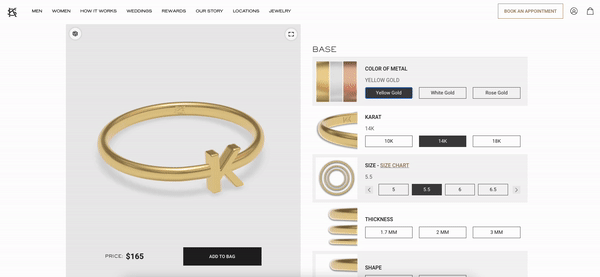5 Ways a Product Configurator Helps With SKU Management

SKU management and inventory management go hand in hand. Those stock-keeping units (SKUs) can be a merchant's best friend or worst enemy — a lot depends on how SKUs are managed.
For example, suppose an eCommerce merchant offers a series of highly customizable chairs.
Shoppers select a base chair style. From there, buyers choose fabrics and colors. They can design a chair with cushions that use different fabrics and colors from those used on the chair's frame. There's an option to add trim to the frame of the chair.
The problem comes when the possible configurations increase and the SKUs multiply.
With a product configurator, merchants can manage their inventory in real time. They can integrate their product catalog with their inventory management software, leading to better warehouse management and more profitability.
Product configurators can streamline back-office management without impacting the customer experience.
What is SKU management?
An SKU is a unique number that an eCommerce merchant assigns to its products. The merchant sets the numbering conventions used to facilitate product delivery.
A SKU assigned to an item in a product catalog should correspond to an SKU in the warehouse so the appropriate item can be pulled for delivery.
SKUs are often used as a shorthand for identifying products. For example, the chair merchant may use an SKU such as AB-BLU- BLU-BRZ to indicate the chair brand (AB) with a blue frame (BLU) and cushions (BLU) with bronze trim (BRZ).
The system is great when there are only a few options. But what happens when the chair comes in 12 different frames and cushion colors with an option for six cushion designs and four types of trim?
Universal Product Codes (UPCs) are another way to identify products. It is a worldwide system used for tracking items.
Manufacturers typically assign UPC using a standardized model. The UPC is a 12-digit number and its corresponding bar code. It helps identify products when they are scanned at POS checkouts.
Online sales do not require UPCs. However, some merchants who sell at retail stores and online use the UPCs.
5 ways to improve SKU management with a product configurator
SKUs provide more flexibility for online merchants who want to track inventory, perform sales analysis and streamline operations. Check out these five key ways a product configurator can help with your efforts to streamline operations with better SKU management:
1. Product catalogs
Product configurators that manage online catalogs at the component level make it easier to issue a bill of materials for customized orders. If the AB chair no longer comes in six cushion designs, then stores can simply remove the SKU codes at the component level.
But without that flexibility, merchants must go through SKUs to eliminate those numbers that referenced the six cushion designs. That equates to 12 frame colors times 6 cushion designs for a total of 72 SKUs, and that doesn't even include the trim options.
Maintaining large numbers of SKUs is not only time-consuming but also invites error. Reversing numbers or mistyping a series of letters can result in hours of retyping.
With a system that can help automate the process, the resulting catalog has the correct SKUs associated with every product.
2. Inventory management
Using SKU codes facilitates better inventory management.
With a well-designed SKU architecture, retailers can avoid lost revenue because of stockouts. Inventory is more accurate, and overstocked items can be removed to minimize funds tied up in unsellable inventory.
Product configurators can give merchants better inventory control. When components are used in multiple products, having component-level visibility ensures that inventory is available to support all products using the shared component.
Without that capability, a shopper could purchase a chair only to discover that the desired cushions are unavailable. Knowing stock levels ensures a positive customer experience.
3. Streamlined operations
Product configurators don’t just improve flexibility. They can also streamline operations.
Letting retailers set up SKU codes to match their product lines makes it easier for their employees to identify the product. Carrying the SKU numbers from the product catalog to an itemized bill of materials also minimizes the chance of human error.
Operating from a centralized product configurator ensures that changes made to existing SKUs can be shared across your delivery team. Multiple entries of the same numbers are not required because all data is maintained in a single system.
Fewer errors mean more accurate inventory levels and less overstocking. These are all features that increase profitability.
4. Better warehouse management

For eCommerce businesses using warehousing services, product configurators with a flexible SKU management system can ensure that all orders are fulfilled correctly. Order management is just as crucial to a positive customer experience as the product catalog itself.
A recent survey found that 97% of consumers decide to continue to do business with a merchant based on how well they handle an order error. In fact, over 40% expect the correct order to be delivered within two to three days from notification.
Providing SKUs that carry through from a product catalog to delivery can optimize the use of warehousing services.
5. Clearer profitability
Product configurators are more than SKU management tools. They can correlate SKU with product visuals, making it easier to identify the ordered items.
They can integrate with other applications to identify reorder points and inventory levels, ensuring that merchants have the right amount of inventory at all times.
Displaying 3D images for customized items such as sheds or swing sets can help buyers see the components. With component-level SKU capabilities, a product configurator can then generate a bill of materials with each line item identified with its own SKU.
This ability can minimize errors in fulfillment that would otherwise result in costly returns.
With systems that carry SKUs across product lines and integrate with ERP solutions, merchants can streamline operations while reducing human error. Business owners can use the information for auditing and optimization of inventory and product lines.
These capabilities enable retailers to increase profitability.
SKUs are an excellent way for online merchants to manage their inventory. They are less costly than UPCs and provide a level of visibility that may not be available with other coding methods.
By combining SKU management with a product configurator that offers 360-degree views and zoom capabilities, business owners can ensure a positive customer experience.
Threekit's product configurator enables eCommerce business owners to dynamically update SKUs and assign numbers at the component level. By tying SKUs to product images created with its virtual photographer, its product configurator makes it easy to manage inventory from a single platform.
With its integration into multiple eCommerce platforms and its ability to import and export data, the configurator can help with forecasting and enterprise-wide reporting. Contact us to learn more about Threekit's product configurator and its SKU management capabilities.




